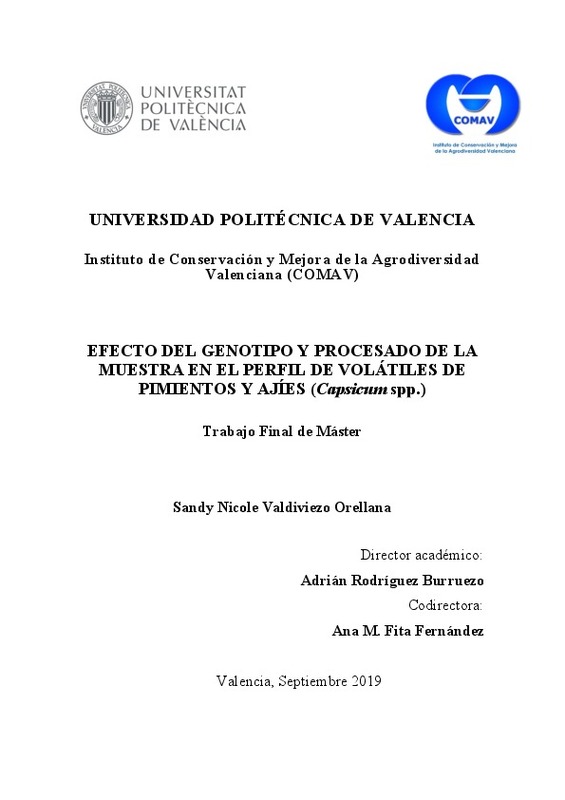JavaScript is disabled for your browser. Some features of this site may not work without it.
Buscar en RiuNet
Listar
Mi cuenta
Estadísticas
Ayuda RiuNet
Admin. UPV
Efecto del genotipo y procesado de la muestra en el perfil de volátiles de pimientos y ajíes (Capsicum spp.)
Mostrar el registro sencillo del ítem
Ficheros en el ítem
| dc.contributor.advisor | Rodríguez Burruezo, Adrián
|
es_ES |
| dc.contributor.advisor | Fita Fernández, Ana María
|
es_ES |
| dc.contributor.advisor | Moreno Peris, Estela
|
es_ES |
| dc.contributor.author | Valdiviezo Orellana, Sandy Nicole
|
es_ES |
| dc.date.accessioned | 2020-01-10T07:40:44Z | |
| dc.date.available | 2020-01-10T07:40:44Z | |
| dc.date.created | 2019-09-25 | |
| dc.date.issued | 2020-01-10 | es_ES |
| dc.identifier.uri | http://hdl.handle.net/10251/134154 | |
| dc.description.abstract | [ES] Los frutos del género Capsicum corresponden a los alimentos vegetales más populares e importantes económicamente a nivel mundial, siendo reconocidos por sus atributos sensoriales a nivel de color, aroma y pungencia. Las propiedades del aroma se encuentran relacionadas con los compuestos volátiles presenten en el fruto, los cuales pueden tener perfiles específicos según la variedad. Esta composición se podría ver afectada por el tipo de procesamiento y conservación que se aplique al material vegetal. Por lo tanto, el objetivo de este estudio se basó en examinar el perfil de volátiles de una colección de 8 accesiones de pimientos y ajíes, que incluían las especies C. annuum, C. chinense, C. frutescens y C. baccatum, para comparar el efecto de la congelación (-30ºC y -80ºC) y liofilización sobre sus componentes volátiles. Las evaluaciones se realizaron a las muestras en fresco y a los tres meses, luego de cada tratamiento. En el caso de la congelación a -30ºC, se realizó una segunda lectura a los 6 meses. Los volátiles se aislaron con la técnica de microextracción en fase sólida en el espacio en cabeza (HS-SPME) y se analizaron mediante cromatografía de gases y espectrometría de masas (GC¿MS). Se identificaron 102 compuestos incluyendo ésteres, sesquiterpenos, monoterpenos, pirazinas, alcoholes, aldehídos, norcarotenoides, alcanos, ácidos carboxílicos y derivados fenólicos. Se encontraron diferencias cualitativas y cuantitativas entre las variedades, siendo C. frutescens y C. chinense las accesiones con mayor concentración y número de volátiles. En cuanto a los tratamientos de conservación, se determinó que el método más adecuado fue la congelación debido a que con la liofilización se tuvieron varios cambios significativos en el perfil de volátiles de las muestras. Además, se puede mantener el material vegetal por un periodo de 6 meses a -30ºC sin distinguir alteraciones considerables en el perfil de volátiles, salvo ciertas excepciones. | es_ES |
| dc.description.abstract | [EN] The fruits of the Capsicum genus are one of the most popular plants consumed and economically important worldwide, being recognized for their sensory attributes In color, aroma and pungency. The aroma properties of spices are related to the volatile compounds present in the fruit, which may have specific profiles depending on the variety. This volatile composition can be affected by the type of processing and conservation method applied to the plant material. Therefore, the aim of this study was to examine the volatile profile of a collection of 8 accessions of peppers and chilis, which included the species C. annuum, C. chinense, C. frutescens and C. baccatum, to compare the effect of freezing (-30ºC and -80ºC) and freeze-drying on its volatile components. Test were carried out on fresh samples and after three months. In the case of freezing at -30 ° C, a second reading was made at 6 months. The volatiles were isolated by headspace-solid phase microextraction (HS-SPME) and analyzed by gas chromatography¿mass spectrometry (GC¿MS). 102 compounds were identified including esters, sesquiterpenes, monoterpenes, pyrazines, alcohols, aldehydes, norcarotenoids, alkanes, carboxylic acids and phenolic derivatives. Qualitative and quantitative differences were found among the varieties, C. frutescens and C. chinense were the accessions with the highest concentration and number of volatiles. Regarding the conservation treatments, the most suitable method was freezing instead of freeze-drying. The freeze-dried samples exhibited a huge significative change in the volatile component profile. In addition, the plant material could be maintained for a period of 6 months at -30 ° C without distinguishing considerable changes in the volatile profile, except in some cases. | es_ES |
| dc.language | Español | es_ES |
| dc.publisher | Universitat Politècnica de València | es_ES |
| dc.rights | Reserva de todos los derechos | es_ES |
| dc.subject | Pimiento | es_ES |
| dc.subject | Aroma | es_ES |
| dc.subject | Cromatografia gases | es_ES |
| dc.subject | Espectrometria masas | es_ES |
| dc.subject | Variabilidad genética | es_ES |
| dc.subject | Evolución volátiles | es_ES |
| dc.subject | Congelación | es_ES |
| dc.subject | Liofilizado | es_ES |
| dc.subject | Peppers | es_ES |
| dc.subject | Gas chromatography | es_ES |
| dc.subject | Mass spectrometry | es_ES |
| dc.subject | Genetic diversity | es_ES |
| dc.subject | Volatiles evolution | es_ES |
| dc.subject | Freezing | es_ES |
| dc.subject | Freeze-drying | es_ES |
| dc.subject.classification | GENETICA | es_ES |
| dc.subject.other | Máster Universitario en Mejora Genética Vegetal-Màster Universitari en Millora Genètica Vegetal | es_ES |
| dc.title | Efecto del genotipo y procesado de la muestra en el perfil de volátiles de pimientos y ajíes (Capsicum spp.) | es_ES |
| dc.type | Tesis de máster | es_ES |
| dc.rights.accessRights | Abierto | es_ES |
| dc.contributor.affiliation | Universitat Politècnica de València. Departamento de Biotecnología - Departament de Biotecnologia | es_ES |
| dc.description.bibliographicCitation | Valdiviezo Orellana, SN. (2019). Efecto del genotipo y procesado de la muestra en el perfil de volátiles de pimientos y ajíes (Capsicum spp.). http://hdl.handle.net/10251/134154 | es_ES |
| dc.description.accrualMethod | TFGM | es_ES |
| dc.relation.pasarela | TFGM\111897 | es_ES |






